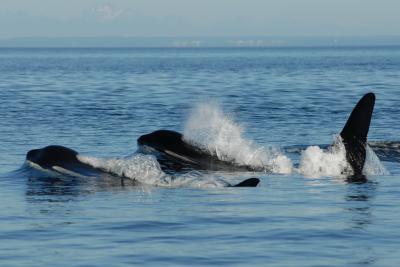
SAN FRANCISCO — For killer whales, silence is golden as they hunt in complete darkness, listening for sounds of their marine mammal prey, and then rushing in for the kill, new research suggests.
"The mammal hunters are very, very silent," said study co-author Volker Deecke, an animal behavior researcher at the University of Cumbria in England. "Most of the time you don't hear any calls or clicks and it's only after a kill that they become vocal."
That conclusion, presented here today (Dec. 3) at the 166th meeting of the Acoustical Society of America, came from studying a population of killer whales that live in the waters off southeastern Alaska and hunt prey such as porpoises and seals.
Killer whales, also known as orcas, often hunt in packs and can take down whales and sharks, giving them the reputation as "wolves of the sea." Two distinct populations of killer whales — ones that feed primarily on salmon, and a second group that prowls for marine mammals such as seals, porpoises and sea lions — live in the region where Deecke and his colleagues were studying orcas. [Image Gallery: Russia's Beautiful Killer Whales]
"The two types don't interact, they don't interbreed, they're almost different species in the making," Deecke told LiveScience.
The fish-eating whales are vocal, clicking and calling to each other to echolocate food.
But the mammal hunters are largely silent. To find out how the quiet behemoths were finding prey, Deecke and his colleagues attached microphones and motion-tracking devices to 13 of the mammal hunters during the summer.
Sign up for the Live Science daily newsletter now
Get the world’s most fascinating discoveries delivered straight to your inbox.
The team found that during the two hours of darkness in the far northern summer nights, the orcas were silent and were often hunting. That rules out the idea that they rely solely on their vision to find food.
Without echolocation, that left only one possibility: They were eavesdropping on the sounds of prey breathing, surfacing or calling to each other.
In one gory recording from a juvenile orca, the team heard the distant roars of harbor seals gradually getting closer, until three very loud roars burst out, and then about 30 seconds later "the sounds of ramming and bones crushing and flesh ripping and no more roars after that," Deecke said.
Only after the slaughter do the killers in the pack vocalize to each other. Deecke suspects that's because the process of dismembering the large animals is a precise dance necessitating communication, with one whale holding the prey while another rips it apart. (Killer whales sometimes hunt small seals or porpoises alone, but most prey is so fast or massive that they must hunt in packs.)
"They're not just wolfing seals down, they are almost butchering them in an almost precise way," Deecke said.
The gruesome sounds, however evocative, are just circumstantial evidence that the whales hunt by eavesdropping. To cinch the case, the team wants to play sounds from seals or other prey roaring, and then track whether the killer whales pursue the sounds.
The researchers suspect that fish and marine mammal-eating killer whales have developed such different communication strategies because of their prey. The prey fish don't hear in the sound frequencies the orcas use to echolocate, so the fish-eating orcas have no need to be silent.
In contrast, marine mammals have excellent hearing in the sound frequencies that orcas use to communicate. So during the hunt, the killer whales must keep quiet.
"The social dinner party is not really an option for them," Deecke said.
Follow Tia Ghose on Twitter and Google+. Follow LiveScience @livescience, Facebook & Google+. Original article on LiveScience.

Tia is the managing editor and was previously a senior writer for Live Science. Her work has appeared in Scientific American, Wired.com and other outlets. She holds a master's degree in bioengineering from the University of Washington, a graduate certificate in science writing from UC Santa Cruz and a bachelor's degree in mechanical engineering from the University of Texas at Austin. Tia was part of a team at the Milwaukee Journal Sentinel that published the Empty Cradles series on preterm births, which won multiple awards, including the 2012 Casey Medal for Meritorious Journalism.










